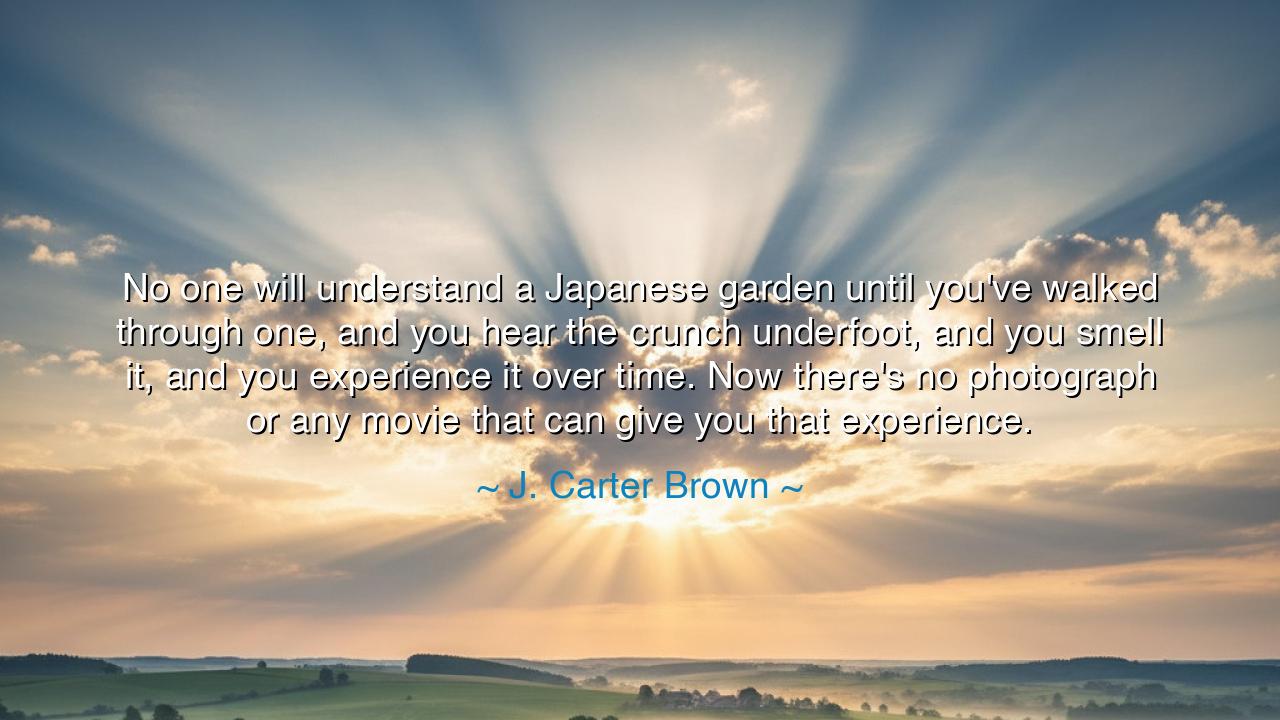
No one will understand a Japanese garden until you've walked
No one will understand a Japanese garden until you've walked through one, and you hear the crunch underfoot, and you smell it, and you experience it over time. Now there's no photograph or any movie that can give you that experience.






In the quiet spaces of the world, there are experiences that cannot be captured by mere images or fleeting moments on film. J. Carter Brown speaks of one such experience when he says, "No one will understand a Japanese garden until you've walked through one, and you hear the crunch underfoot, and you smell it, and you experience it over time. Now there's no photograph or any movie that can give you that experience." These words hold within them a profound truth that the essence of life’s most sacred spaces cannot be understood through the eyes alone. To truly experience something, to truly know it, one must immerse themselves in it—feel it with their senses, live in it with their being. In this, the Japanese garden becomes a metaphor for all the experiences that demand our full presence and attention.
The ancients understood that experience and presence were the gateways to wisdom. The great philosophers of Greece spoke often of the need to step beyond intellectual knowledge and engage with the world on a deeper level. Socrates, in his dialogues, encouraged his followers to experience life’s lessons, to learn through the senses and through direct engagement with the world around them. He understood that while words and images could convey ideas, it was only through living the experience that one could truly understand it. The Japanese garden, in its quiet design, calls us to leave behind the passive consumption of images and to step fully into the experience of nature’s order and beauty.
In Japan, the garden is seen as a sacred space, a space where the natural world is harmonized with the spiritual and the aesthetic. The Zen tradition, with its emphasis on meditation and awareness, has deeply influenced the design of these gardens. The stones, the gravel, the plants—each element is carefully placed, not merely for beauty, but to create an experience that guides the visitor into a state of mindfulness and presence. A Zen garden is not just a place to admire from afar; it is a space that invites you to walk slowly, to listen to the sound of your footsteps, to observe how the light shifts across the landscape. The crunch underfoot that Brown speaks of is not just a sound—it is a reminder that to experience something fully, you must engage with it, with your senses and your mind, as part of the whole.
The garden is also a place of transformation, where the natural world is molded into something that reflects deeper truths. In ancient China, gardens were designed to reflect the Taoist principles of harmony between opposites. The arrangement of plants, water, and rocks was meant to reflect the balance of yin and yang, the forces that shape the universe. Just as the Japanese garden invites one to experience nature’s simplicity and complexity, so too did the Chinese garden offer a spiritual path—one that could not be understood by merely looking at it from the outside. The garden, like life itself, must be entered and experienced to be understood.
There is a powerful lesson in Brown’s words, one that reminds us of the limitations of surface-level knowledge. In our modern world, we are often surrounded by images, videos, and media that attempt to convey experiences to us. We see pictures of the great and beautiful places in the world, but we miss the depth of those places when we do not step into them. A photograph, no matter how beautiful, cannot capture the smell of the earth, the crunch of the gravel, or the stillness that settles over you when you stand in a sacred space. Just as a photograph cannot convey the full experience of a Japanese garden, so too do we often miss the depth of life’s experiences when we pass through them without truly engaging. To understand life, we must live it, walk through it, feel it with all of our senses.
Consider the story of the great Japanese tea masters—those who, over centuries, cultivated not just the practice of making tea, but the entire experience of being present in the act. Every movement in the tea ceremony is intentional, from the way the tea is poured to the way the bowl is passed. It is a process that demands complete presence, and it reflects the same principles that govern the Japanese garden: that beauty and understanding come from full engagement. To experience the garden, or the tea ceremony, is to immerse oneself fully, to experience the world as it is without the veil of distraction or distance. It is only through this engagement that one can truly understand the peace, balance, and depth that these practices offer.
Thus, the lesson of Brown’s words is one of presence and engagement. Just as the garden cannot be fully appreciated through mere observation, so too must we approach life with intentionality and awareness. The garden calls us to slow down, to listen, to engage with the world around us, not as passive spectators but as active participants. Whether we are in a garden, at the dinner table, or on a walk through the forest, we must learn to be fully present—to engage our senses, to appreciate the small, fleeting moments, and to understand that life’s richness is found not in the images we collect, but in the experiences we live. Let us take time to step into the world, to feel its beauty, and to experience it in its fullness, knowing that the true understanding of life can only come when we walk through it with open hearts and attuned minds.






AAdministratorAdministrator
Welcome, honored guests. Please leave a comment, we will respond soon